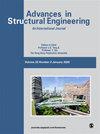Optimization of dynamic parameter design of Stewart platform with Particle Swarm Optimization (PSO) algorithm
IF 2
4区 工程技术
引用次数: 0
Abstract
Today motion simulators are being produced rely on electric actuators. The conventional way of dealing with high velocity, accelerations, and bulky payload is using a bigger actuator, but this leads to increased power usage and costs. To overcome these limitations, an optimized design of the Stewart platform design parameter improves simulators’ ability to support the weight of the equipment and satisfy the desired velocity and acceleration. However, it is challenging to set platform design parameters to maintain efficiency across the entire workspace. In this article, the kinematics and dynamics of the six-axis general Stewart robot are explored. A high-rated desired velocity and acceleration for the Stewart platform are defined and simulated. Then, the electric actuator force during some motion trajectory based on the defined workspace, velocity, and acceleration are calculated. Particle Swarm Optimization (PSO) is employed to optimize platform design parameters. The algorithm defines a cost function to minimize the maximum speed and maximum Force of the actuator by examining the structural kinematics arrangement of design parameters. Findings demonstrate that optimized design parameters have been successful in reducing the maximum actuator power 88.3%. Additionally, improves Stewart platform mechanical components’ life. These procedures can be employed for any Stewart platform.利用粒子群优化(PSO)算法优化斯图尔特平台的动态参数设计
目前生产的运动模拟器主要依靠电动推杆。处理高速度、高加速度和大体积有效载荷的传统方法是使用更大的推杆,但这会导致用电量和成本增加。为了克服这些限制,斯图尔特平台设计参数的优化设计提高了模拟器支持设备重量并满足所需速度和加速度的能力。然而,设置平台设计参数以保持整个工作空间的效率是一项挑战。本文探讨了六轴通用斯图尔特机器人的运动学和动力学。本文定义并模拟了斯图尔特平台的高额定期望速度和加速度。然后,根据定义的工作空间、速度和加速度计算出某些运动轨迹中的电动致动器力。采用粒子群优化算法(PSO)来优化平台设计参数。该算法定义了一个成本函数,通过检查设计参数的结构运动学安排,最小化致动器的最大速度和最大力。研究结果表明,优化的设计参数成功地将推杆的最大功率降低了 88.3%。此外,还提高了斯图尔特平台机械部件的使用寿命。这些程序可用于任何斯图尔特平台。
本文章由计算机程序翻译,如有差异,请以英文原文为准。
求助全文
约1分钟内获得全文
求助全文
来源期刊

Advances in Mechanical Engineering
Engineering-Mechanical Engineering
自引率
4.80%
发文量
353
期刊介绍:
Advances in Mechanical Engineering (AIME) is a JCR Ranked, peer-reviewed, open access journal which publishes a wide range of original research and review articles. The journal Editorial Board welcomes manuscripts in both fundamental and applied research areas, and encourages submissions which contribute novel and innovative insights to the field of mechanical engineering
 求助内容:
求助内容: 应助结果提醒方式:
应助结果提醒方式:


